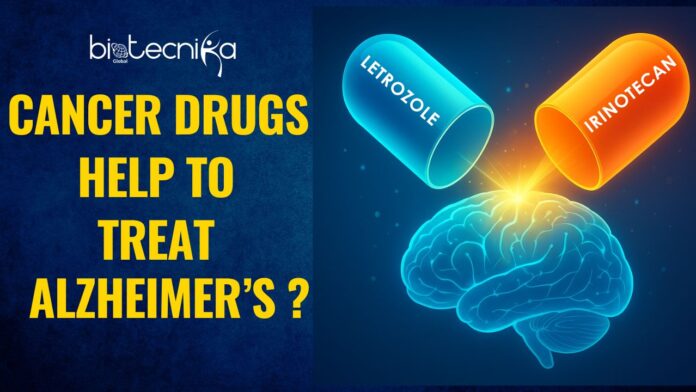Cancer Drugs – Alzheimer’s Treatment
Researchers at the University of California, San Francisco (UCSF) and Gladstone Institutes have discovered that two common cancer drugs, such as Letrozole and Irinotecan, may help fight Alzheimer’s disease with a surprising twist.
The study found that these drugs, which were originally designed to treat cancer, can reverse brain damage and restore memory in mice with Alzheimer’s. Though the findings are early, they bring a new ray of hope for millions of families affected by these devastating diseases.
In this article, let’s know more about the discovery and how the re-purposing of drugs is done.
The Study: Seeking New Usage for Old Drugs
Alzheimer’s disease is among today’s most serious health issues. The trend of memory loss cannot be stopped by current therapies. Rather, they only offer temporary relief. Thus, the idea of “drug re-purposing,” or using current drugs for new diseases, is being studied by researchers.
Using cutting-edge computer techniques, UCSF researchers investigated the impact of Alzheimer’s disease on brain gene activity. They then searched for medications that could reverse those damaging genetic changes. A few cancer medications stand out amongst the thousands of drugs approved by the FDA.
Two Drugs That Made an Impact for Alzheimer’s Treatment
After a number of tests, the researchers determined that letrozole and irinotecan were the two most promising options.
- A common treatment for breast cancer is letrozole. It functions by reducing the levels of estrogen in the body.
- Lung and colon cancer are treated with irinotecan. Focusing on specific enzymes, it prevents the growth of cancer cells.
When both medications were tested together on mice exhibiting symptoms similar to Alzheimer’s disease, the results were unexpected. The memory abilities of mice were even partially restored by this combination, which also lessened brain degeneration and the buildup of toxic tau proteins, which are the main cause of Alzheimer’s disease damage.
How the Discovery Happened?
The scientists went beyond what the computer could have predicted. The electronic health records of hundreds of patients who had taken these cancer drugs were also examined. Interestingly, those patients were less likely than others to develop Alzheimer’s. Their experimental findings were supported by this real-world observation, which also made the results seem more credible.
According to Dr. Marina Sirota, one of the senior authors of the study, this discovery shows the promise of combining big data and biology. “We’re thrilled that our computational approach led us to a potential Alzheimer’s combination therapy based on currently available FDA-approved drugs,” she said.
Importance of Alzheimer’s Treatment
Alzheimer’s Disease affects more than 50 million people around the world, causing gradual memory loss, confusion, and a decline in thinking ability. Despite decades of research, there are only two drugs currently approved to treat it, and neither can meaningfully stop the effects of the disease.
That’s why this new approach is important. By reusing safe, approved drugs, scientists can skip years of early-stage safety testing and move faster toward human trials. This could speed up the development of affordable and effective Alzheimer’s treatments.
Still Early, But Promising
Although the results are interesting, scientists stress that this research is still in its early stages. Only mice have been used in the experiments so far, and what works for animals doesn’t always work for people.
The right dosage, safety levels, and timing for Alzheimer’s patients will need to be determined by future research. Careful monitoring will also be necessary for side effects, particularly from cancer medications. Planning clinical trials to determine whether these outcomes also apply to patients is the next stage.
A New Direction in Alzheimer’s Research
The study also demonstrates how the mission of medicine is evolving. Scientists are increasingly taking a fresh look at existing drugs rather than creating new ones. In addition to saving time, this approach may have vast advantages, such as protecting the brain from cancer drugs.
This finding contributes to an expanding body of research examining the potential benefits of treating one disease to treat another. It also represents attempts to identify patterns in enormous amounts of genetic and medical data using data science and artificial intelligence.
Letrozole and Irinotecan may be included in a new class of Alzheimer’s treatments. They not only reduce the symptoms but also repair brain damage if additional research validates the findings. Researchers are cautious but hopeful for the time being. Science is getting closer to comprehending and potentially curing Alzheimer’s disease with each new discovery!






